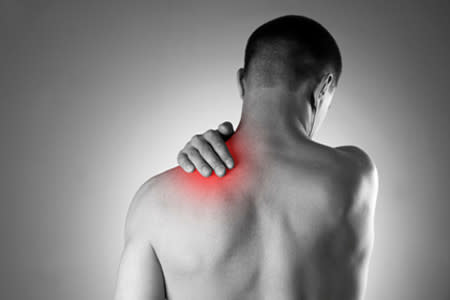Scleroderma: Signs and symptoms
What are the signs of scleroderma?
Scleroderma has many signs and symptoms. The following images let you see some of the ways it can affect your skin.
Hard, thickening, or tight skin
This trait is what gives scleroderma its name. Some people develop 1 or 2 patches of hard, thick skin. Others have widespread patches on their body. The hard, thick skin can feel anchored in place. If you have morphea (more-fee-uh), the most common type of scleroderma, the patches may not feel too hard. In time, the hardened skin may soften.

Hair loss and less sweating
Where you have hardened skin, you’ll often see that the area is shiny, discolored, and has hair loss. The hardened skin also tends to lose its ability to sweat.

Dry skin and itch
Scleroderma causes extremely dry skin, and dry skin itches. The extreme dryness can cause the skin to breakdown and sores can form.

Skin color changes
The patches of hardened skin can be lighter or darker than your natural skin color. Some people develop violet-colored skin, which means that the scleroderma is active and expanding. This patient has darker and lighter (white) areas that are hard to the touch.

Salt-and-pepper look to the skin
This tends to develop on the upper back, chest, or scalp (along the hairline). The skin may feel hard or tight — but not always. If you have a salt-and-pepper look on your skin, you should see a doctor. This can be a sign that you have a type of scleroderma that affects internal organs. The sooner you are diagnosed and treated, the better your prognosis (what is likely to happen).

Stiff joints and difficulty moving them
When the hard, thickening, or tight skin forms over a joint (i.e., the jaw, wrist, or finger), the tightness can make it difficult to move that joint. The patient in this picture cannot fully open her hands because of tight skin. Physical therapy can help you keep the full range of motion. Without it, you may lose the ability to fully straighten or bend a finger, elbow, wrist, or other part of your body.

Muscle shortening and weakness
The hardening and tightening sometimes extends to the muscle. This can cause the muscle to weaken and shorten. You may be unable to stretch the muscle. If you have muscle weakness, it’s important to tell your doctor so that the cause can be found and treated.

Loss of tissue beneath the skin
This girl has a type of scleroderma called Parry-Romberg syndrome (PRS), which can cause loss of muscle, cartilage, and bone. PRS usually affects one side of the face as shown here. It can also affect an arm, leg, or trunk. PRS is very rare. Other forms of scleroderma can also cause loss of tissue beneath the skin.

Bone may not grow as it should
When a child gets some types of scleroderma, such as linear scleroderma or en coup de sabre, the scleroderma can interfere with bone growth. A leg may not develop as it should. If scleroderma affects the head, the face may become deformed. These deformities are rare.

Sores and pitted scars on the fingers
When a person has a type of scleroderma that also affects the internal organs, it’s common to have skin sores. These sores tend to develop on skin that is tightly stretched. Sores are especially common on the fingers. Some people develop pinhead-sized pitted scars on their fingertips and the sides of their fingers.

Calcium deposits beneath the skin
Called calcinosis (KAL-sin-OH-sis), this occurs in the connective tissue beneath the skin. You may feel 1 or more hard, painful lumps beneath your skin. If a calcium deposit breaks through the skin, it can be very painful and you’ll see a white or yellow chalky substance. An infection and painful open sores can develop.

Visible blood vessels
This happens when tiny blood vessels near the surface of the skin swell. You may see tiny red spots, usually on the hands and face. It is not painful, but many people dislike the way these look. Treatment is available.

Extreme sensitivity to cold, stress, or both
This is often an early warning that scleroderma affects the internal organs.
The medical name for this symptom is Raynaud’s phenomenon. It causes certain parts of your body, usually the fingers, toes, ears, or tip of your nose to feel cold and go numb in cold temperatures or when you feel stressed. You skin may turn white and then blue. As the blood flow returns to normal, the affected areas often turn red.
Not everyone with Raynaud’s has scleroderma. The restricted blood flow, however, can cause problems for anyone with scleroderma. Raynaud’s can damage the skin on the fingers, causing sore or pits.
Extreme sensitivity to cold
This is often an early warning that scleroderma affects the internal organs.

When scleroderma affects internal organs
Some types of scleroderma affect the skin and internal organs like the lungs and kidneys. The following symptoms can be a warning sign that scleroderma is affecting an internal organ:
Digestive system
Problems swallowing
Heartburn
Diarrhea
Constipation
Bloated feeling after eating
Weight loss without trying
Other organs
High blood pressure
Abnormal heartbeat
Shortness of breathe
Lack of sex drive
If you have any of these, you should see a dermatologist, rheumatologist, or other doctor who treats scleroderma. The sooner you are diagnosed and treated, the better your outcome.
Images
Images used with permission of Journal of the American Academy of Dermatology:
Image 2: J Am Acad Dermatol. 2011;64(2):217-28.
Image 4: J Am Acad Dermatol. 2009;60(2):248-55.
Image 6: J Am Acad Dermatol. 2000;43(4):670-74.
Image 8: J Am Acad Dermatol. 2012;67(4):769-84.
Image 9: J Am Acad Dermatol. 2008;59(3):385-96.
Image 10: J Am Acad Dermatol. 2006;54(5):880-2.
Image 11: J Am Acad Dermatol. 2011;65(1):1-12.
Images 3, 7, and 13: Getty Images
References
Falanga V and Killoran CE. “Morphea.” In: Wolff K, Goldsmith LA, et al. Fitzpatrick’s Dermatology in General Medicine (seventh edition). McGraw Hill Medical, New York, 2008:543-6.
Fett N and Werth VP. “Update on morphea: Part I. Epidemiology, clinical presentation, and pathogenesis.” J Am Acad Dermatol 2011;64(2):217-28.
Rőcken M and Ghoreschi K. “Morphea and lichen sclerosus.” In: Bolognia JL, et al. Dermatology. (second edition). Mosby Elsevier, Spain, 2008:1469-76.
Singh A, S Ambujam S, et al. “Salt-and-pepper appearance: A cutaneous clue for the diagnosis of systemic sclerosis.” Indian J Dermatol. 2012 Sep-Oct; 57(5): 412–413.
 Atopic dermatitis: More FDA-approved treatments
Atopic dermatitis: More FDA-approved treatments
 Biosimilars: 14 FAQs
Biosimilars: 14 FAQs
 How to trim your nails
How to trim your nails
 Relieve uncontrollably itchy skin
Relieve uncontrollably itchy skin
 Fade dark spots
Fade dark spots
 Untreatable razor bumps or acne?
Untreatable razor bumps or acne?
 Tattoo removal
Tattoo removal
 Scar treatment
Scar treatment
 Free materials to help raise skin cancer awareness
Free materials to help raise skin cancer awareness
 Dermatologist-approved lesson plans, activities you can use
Dermatologist-approved lesson plans, activities you can use
 Find a Dermatologist
Find a Dermatologist
 What is a dermatologist?
What is a dermatologist?